Related Research Articles

Maria Edgeworth was a prolific Anglo-Irish novelist of adults' and children's literature. She was one of the first realist writers in children's literature and was a significant figure in the evolution of the novel in Europe. She held critical views on estate management, politics and education, and corresponded with some of the leading literary and economic writers, including Sir Walter Scott and David Ricardo. During the first decade of the 19th century she was one of the most widely read novelists in Britain and Ireland. Her name today most commonly associated with Castle Rackrent, her first novel in which she adopted an Irish Catholic voice to narrate the dissipation and decline of a family from her own landed Anglo-Irish class.
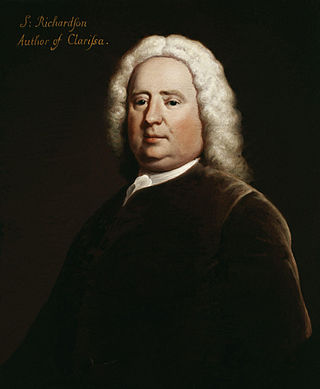
Samuel Richardson was an English writer and printer known for three epistolary novels: Pamela; or, Virtue Rewarded (1740), Clarissa: Or the History of a Young Lady (1748) and The History of Sir Charles Grandison (1753). He printed almost 500 works, including journals and magazines, working periodically with the London bookseller Andrew Millar. Richardson had been apprenticed to a printer, whose daughter he eventually married. He lost her along with their six children, but remarried and had six more children, of whom four daughters reached adulthood, leaving no male heirs to continue the print shop. As it ran down, he wrote his first novel at the age of 51 and joined the admired writers of his day. Leading acquaintances included Samuel Johnson and Sarah Fielding, the physician and Behmenist George Cheyne, and the theologian and writer William Law, whose books he printed. At Law's request, Richardson printed some poems by John Byrom. In literature, he rivalled Henry Fielding; the two responded to each other's literary styles.
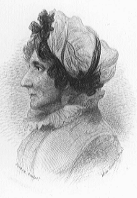
Anna Laetitia Barbauld was a prominent English poet, essayist, literary critic, editor, and author of children's literature. A prominent member of the Blue Stockings Society and a "woman of letters" who published in multiple genres, Barbauld had a successful writing career that spanned more than half a century.

Amelia Opie was an English author who published numerous novels in the Romantic period up to 1828. A Whig supporter and Bluestocking, Opie was also a leading abolitionist in Norwich, England. Hers was the first of 187,000 names presented to the British Parliament on a petition from women to stop slavery.
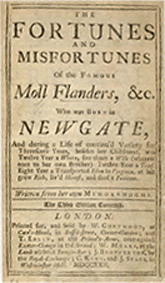
Moll Flanders is a novel by Daniel Defoe, first published in 1722. It purports to be the true account of the life of the eponymous Moll, detailing her exploits from birth until old age.
Sarah Fielding was an English author and sister of the novelist Henry Fielding. She wrote The Governess, or The Little Female Academy (1749), thought to be the first novel in English aimed expressly at children. Earlier she had success with her novel The Adventures of David Simple (1744).

Elizabeth Inchbald was an English novelist, actress, dramatist, and translator. Her two novels, A Simple Story and Nature and Art, have received particular critical attention.

Clarissa; or, The History of a Young Lady: Comprehending the Most Important Concerns of Private Life. And Particularly Shewing, the Distresses that May Attend the Misconduct Both of Parents and Children, In Relation to Marriage is an epistolary novel by English writer Samuel Richardson, published in 1748. It tells the tragic story of a young woman, Clarissa Harlowe, whose quest for virtue is continually thwarted by her family. The Harlowes are a recently wealthy family whose preoccupation with increasing their standing in society leads to obsessive control of their daughter, Clarissa. It is considered one of the longest novels in the English language. It is generally regarded as Richardson's masterpiece.
Penelope Aubin was an English novelist, poet, and translator. She published seven novels between 1721 and 1728. Aubin published poetry in 1707 and turned to novels in 1721; she translated French works in the 1720s, spoke publicly on moral and political issues at her Lady's Oratory in 1729, and wrote a play in 1730. Aubin died in April 1738, survived by her husband until his death in April 1740. After the author's death, her works were gathered and published as A Collection of Entertaining Histories and Novels, Designed to Promote the Cause of Virtue and Honor. Aubin's works have a long history after her death, being both plagiarised and published transatlantically. She is one of a number of eighteenth-century women writers whose works and biography is being more rigorously explored by modern scholars.
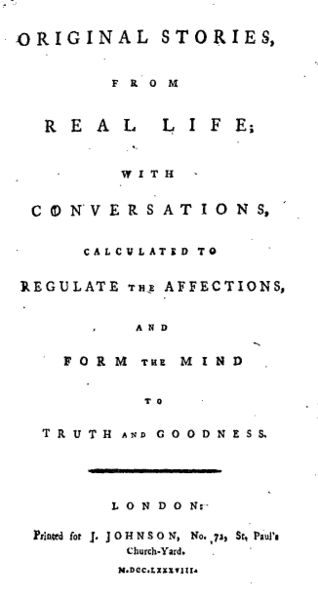
Original Stories from Real Life; with Conversations Calculated to Regulate the Affections, and Form the Mind to Truth and Goodness is the only complete work of children's literature by the 18th-century English feminist author Mary Wollstonecraft. Original Stories begins with a frame story that sketches out the education of two young girls by their maternal teacher Mrs. Mason, followed by a series of didactic tales. The book was first published by Joseph Johnson in 1788; a second, illustrated edition, with engravings by William Blake, was released in 1791 and remained in print for around a quarter of a century.
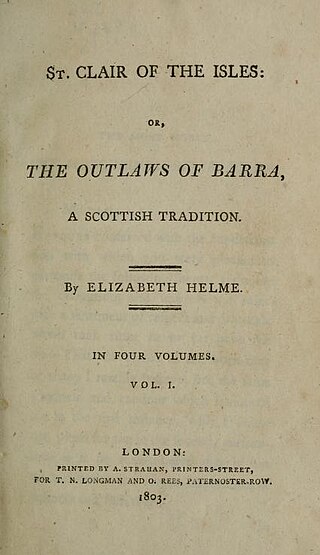
Elizabeth Helme was a prolific English novelist, educational writer, and translator active in the late 18th and early 19th centuries.
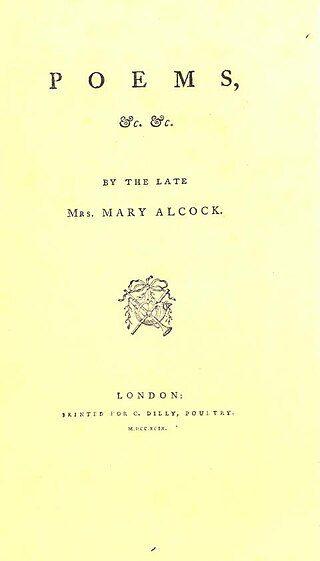
Mary Alcock was an English poet, essayist, and philanthropist. She was part of Lady Anne Miller's literary circle in Bath.
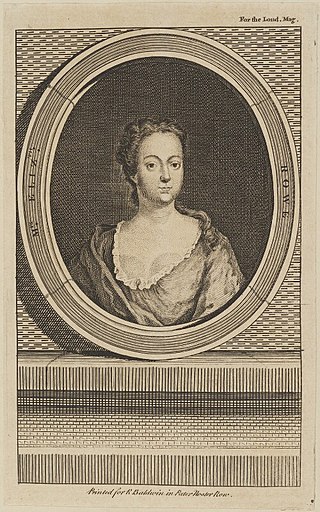
Elizabeth Singer Rowe was an English poet, essayist and fiction writer called "the ornament of her sex and age" and the "Heavenly Singer". She was among 18th-century England's most widely read authors. She wrote mainly religious poetry, but her best-known work, Friendship in Death (1728), is a Jansenist miscellany of imaginary letters from the dead to the living. Despite a posthumous reputation as a pious, bereaved recluse, Rowe corresponded widely and was involved in local concerns at Frome in her native Somerset. She remained popular into the 19th century on both sides of the Atlantic and in translation. Though little read today, scholars have called her stylistically and thematically radical for her time.

Proserpine is a verse drama written for children by the English Romantic writers Mary Shelley and her husband Percy Bysshe Shelley. Mary wrote the blank verse drama and Percy contributed two lyric poems. Composed in 1820 while the Shelleys were living in Italy, it is often considered a partner to the Shelleys' play Midas. Proserpine was first published in the London periodical The Winter's Wreath in 1832. Whether the drama was ever intended to be staged is a point of debate among scholars.

Thoughts on the education of daughters: with reflections on female conduct, in the more important duties of life is the first published work of the British feminist Mary Wollstonecraft. Published in 1787 by her friend Joseph Johnson, Thoughts is a conduct book that offers advice on female education to the emerging British middle class. Although dominated by considerations of morality and etiquette, the text also contains basic child-rearing instructions, such as how to care for an infant.

Madeleine d'Arsant de Puisieux (1720–1798), was a French writer and active feminist.

Elizabeth Teft was the author of a miscellany of occasional, topical, and political poetry. Although little is known of her life, her work has garnered scholarly interest.

Anna Maria Mackenzie was a prolific author of popular novels active during the late eighteenth and early nineteenth centuries. She was closely associated with the Minerva Press.
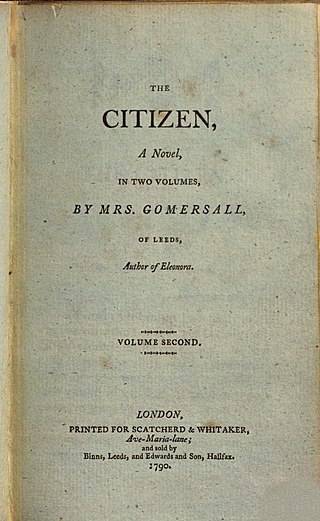
Ann Gomersall was a British novelist of the Romantic-era who paid close attention to economic and social issues in her writing.
Jane Johnson was an English vicar’s wife who wrote letters, poetry, children’s fiction and teaching aids. Although none of her work was published during her life, it has since been studied as part of the history of education, children’s fiction, and epistolary literacy.
References
- 1 2 "Susan Smythies © Orlando Project". orlando.cambridge.org. Retrieved 2020-09-24.
- 1 2 3 4 5 Sherbo, Arthur (2004). "Smythies, Susan (b. 1720), writer" . Oxford Dictionary of National Biography (online ed.). Oxford University Press. doi:10.1093/ref:odnb/72236 . Retrieved 2020-09-24.(Subscription or UK public library membership required.)
- ↑ Blackwell, Mark (2007). The Secret Life of Things: Animals, Objects, and It-narratives in Eighteenth-century England. Bucknell University Press. pp. 135–8. ISBN 978-0-8387-5666-9.
- ↑ Joule, Victoria (2017). "A Stage-Coach Journey" (PDF). The Female Spectator from Chawton House Library. 3 (2): 4–5.
- ↑ D'Cruze, Shani (2008). A Pleasing Prospect: Society and Culture in Eighteenth-century Colchester. Univ of Hertfordshire Press. ISBN 978-1-902806-73-0.
- ↑ Turner, Cheryl (1994). Living by the Pen: Women Writers in the Eighteenth Century. Psychology Press. ISBN 978-0-415-11196-6.